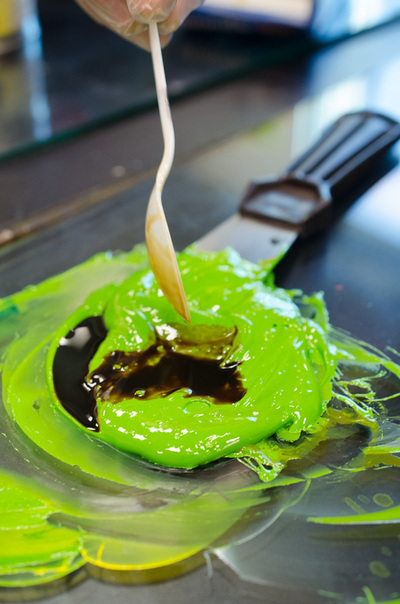Kim Fink

Prints
In March 2014, Flat Tail Press hosted guest artist, Kim Fink. During his visit, Fink completed a suite of prints inspired by the activity in North Dakota’s Bakken oil fields. According to Fink, the images are produced not by an active participant or resident of the region, but by an “observer” through “hear say.” The prints expound upon rumors and conjecture passed along by word of mouth or voices of the media, often touching on the environmental impact of fracking. For example, “Farmer Henry’s Cow” was inspired by the accusation of a Bakken cattle rancher, claiming that local oil production was the culprit behind the mysterious disappearance of tails on his herd of cattle.
Process
The print suite is a combination of processes, primarily screen print and wood cut, and in a gesture to meld imagery to content, Fink mixed Bakken crude oil into the oil- based inks. The application of the background colors was achieved by soaking the backside of the paper with solvent and then applying inks directly with a brayer. The ink and solvent soaked through the thin Okawara paper, and left a unique coloration on the image side of the print. Before this last step, the editioned prints look largely the same, but the unpredictable migration of pigments through paper resulted in a “variable edition.” Throughout this process, students worked alongside Fink, assisting with the color soaking and additional screen printing.
The Suite
Eagle’s Nest Media: Screen print/ Woodcut
Farmer Henry’s Cow Edition: 10
Ram’s Head Size: 16” x 19 ¼”
Bakken Paper: Okawara
Gambler’s Delight
Kim Fink
Kim Fink lives in Grand Forks, ND and teaches printmaking at the University of North Dakota. More information is available at www.kimfink.com.
In March 2014, Flat Tail Press hosted guest artist, Kim Fink. During his visit, Fink completed a suite of prints inspired by the activity in North Dakota’s Bakken oil fields. According to Fink, the images are produced not by an active participant or resident of the region, but by an “observer” through “hear say.” The prints expound upon rumors and conjecture passed along by word of mouth or voices of the media, often touching on the environmental impact of fracking. For example, “Farmer Henry’s Cow” was inspired by the accusation of a Bakken cattle rancher, claiming that local oil production was the culprit behind the mysterious disappearance of tails on his herd of cattle.
Process
The print suite is a combination of processes, primarily screen print and wood cut, and in a gesture to meld imagery to content, Fink mixed Bakken crude oil into the oil- based inks. The application of the background colors was achieved by soaking the backside of the paper with solvent and then applying inks directly with a brayer. The ink and solvent soaked through the thin Okawara paper, and left a unique coloration on the image side of the print. Before this last step, the editioned prints look largely the same, but the unpredictable migration of pigments through paper resulted in a “variable edition.” Throughout this process, students worked alongside Fink, assisting with the color soaking and additional screen printing.
The Suite
Eagle’s Nest Media: Screen print/ Woodcut
Farmer Henry’s Cow Edition: 10
Ram’s Head Size: 16” x 19 ¼”
Bakken Paper: Okawara
Gambler’s Delight
Kim Fink
Kim Fink lives in Grand Forks, ND and teaches printmaking at the University of North Dakota. More information is available at www.kimfink.com.













